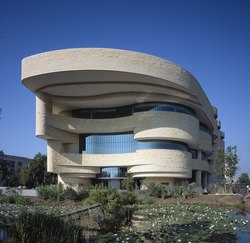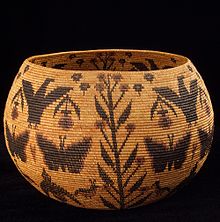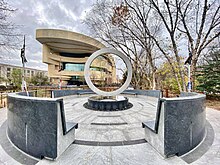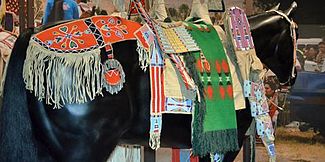
The Smithsonian Institution, or simply the Smithsonian, is a group of museums, education and research centers, the largest such complex in the world, created by the U.S. government "for the increase and diffusion of knowledge." Founded on August 10, 1846, it operates as a trust instrumentality and is not formally a part of any of the three branches of the federal government. The institution is named after its founding donor, British scientist James Smithson. It was originally organized as the United States National Museum, but that name ceased to exist administratively in 1967.

The National Museum of the American Indian–New York, the George Gustav Heye Center, is a branch of the National Museum of the American Indian at the Alexander Hamilton U.S. Custom House in Manhattan, New York City. The museum is part of the Smithsonian Institution. The center features contemporary and historical exhibits of art and artifacts by and about Native Americans.

Suzan Shown Harjo is an American advocate for Native American rights. She is a poet, writer, lecturer, curator, and policy advocate who has helped Native peoples recover more than one million acres (4,000 km²) of tribal lands. After co-producing the first American Indian news show in the nation for WBAI radio while living in New York City, and producing other shows and theater, in 1974 she moved to Washington, D.C., to work on national policy issues. She served as Congressional liaison for Indian affairs in the President Jimmy Carter administration and later as president of the National Council of American Indians.

The National Museum of the American Indian Act was enacted on November 28, 1989, as Public Law 101-185. The law established the National Museum of the American Indian as part of the Smithsonian Institution. The law also required the Secretary of the Smithsonian to prepare an inventory of all Indian and Native Hawaiian human remains and funerary objects in Smithsonian collections, as well as expeditiously return these items upon the request of culturally affiliated federally recognized Indian tribes and Native Hawaiian organizations.

George Gustav Heye was an American collector of Native American artifacts in the Western Hemisphere, particularly in North America. He founded the Museum of the American Indian, and his collection became the core of the National Museum of the American Indian.
According to Zuni mythology, Ahayu'da are the twin gods of war. They are also physical representations endowed with certain spiritual powers.
Mario Martinez is a Native American contemporary abstract painter. He is a member of the Pascua Yaqui Tribe from New Penjamo, the smallest of six Yaqui settlements, in Arizona. He currently lives in New York City.

George Morrison was an Ojibwe abstract painter and sculptor from Minnesota. His Ojibwe name was Wah Wah Teh Go Nay Ga Bo. Morrison's work is associated with the Abstract Expressionist movement in the United States.
Frederick Webb Hodge was an American editor, anthropologist, archaeologist, and historian. Born in England, he immigrated at the age of seven with his family to Washington, DC. He was educated at American schools, and graduated from Cambridge College.
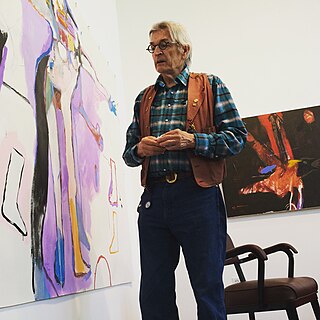
Richard Elmer "Rick" Bartow was a Native American artist and a member of the Mad River band of the Wiyot Tribe, who are indigenous to Humboldt County, California. He primarily created pastel, graphite, and mixed media drawings, wood sculpture, acrylic paintings, drypoint etchings, monotypes, and a small number of ceramic works.
Gail Tremblay was an American writer and artist from Washington State. She is known for weaving baskets from film footage that depicts Native American people, such as Western movies and anthropological documentaries. She received a Washington State Governor's Arts and Heritage Award in 2001.

Always Becoming is an artwork created in 2007 by Nora Naranjo-Morse, a Native American potter and poet. The artwork groups five sculptures made with natural materials, which allows them to gradually change over time. The National Museum of the American Indian selected and commissioned the artwork to be exhibited at one of its entrances in 2006.

Horace Poolaw (1906–1984) was a Kiowa photographer from Mountain View, Oklahoma.
Stephen Mopope (1898–1974) was a Kiowa painter, dancer, and Native American flute player from Oklahoma. He was the most prolific member of the group of artists known as the Kiowa Six.
Terence Patrick Winch is an Irish-American poet, writer, and musician.
Frank Day, also Ly-dam-lilly was a Native American artist from California.
Pablita Abeyta was a Native American activist and sculptor born in Gallup, New Mexico, United States. The eldest daughter of Sylvia Ann (Shipley) Abeyta and artist Narciso Abeyta. Her family was originally from the Cañoncito Band of the Navajo Reservation in New Mexico, located west of Albuquerque. In 2000 the reservation decided to change its name to To'Hajiilee.
Judith Lowry is a Native American artist. Based in Northern California, she is Maidu and Achomawi and enrolled in the Pit River Tribe. Lowry primarily works in acrylics on canvas.

Elizabeth Conrad Hickox was a Wiyot master basket weaver and was considered one of the finest basket-weavers of her time. Her baskets differ from other Lower Klamath baskets through her own unique use of shape, technique, color scheme and design.
C. Maxx Stevens is an installation artist from the Seminole/Mvskoke Nation of Oklahoma. She often uses found objects and ephemera in her work which is centered on the concept of memories and stories. Stevens’ work has been described as “gritty and “both haunting and familiar” and prior installations have focused on the contemporary Native American experience such as the harmful effects of diabetes in Native American communities.

